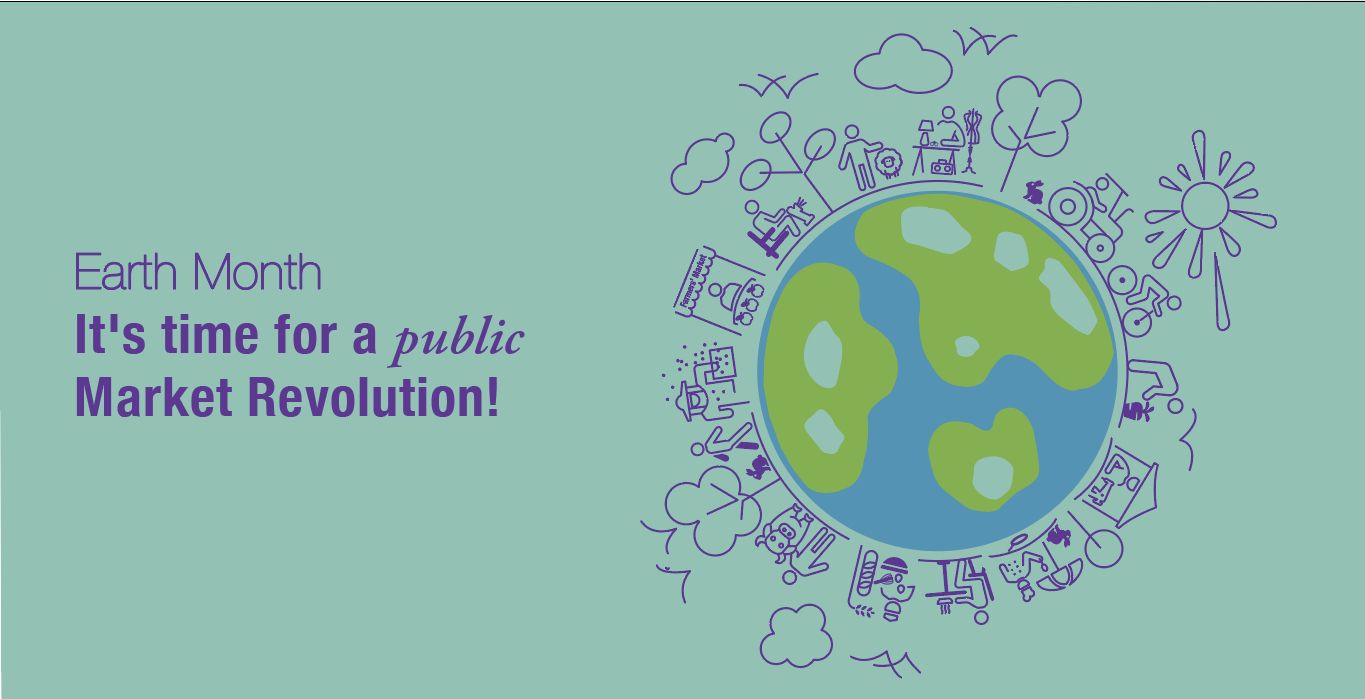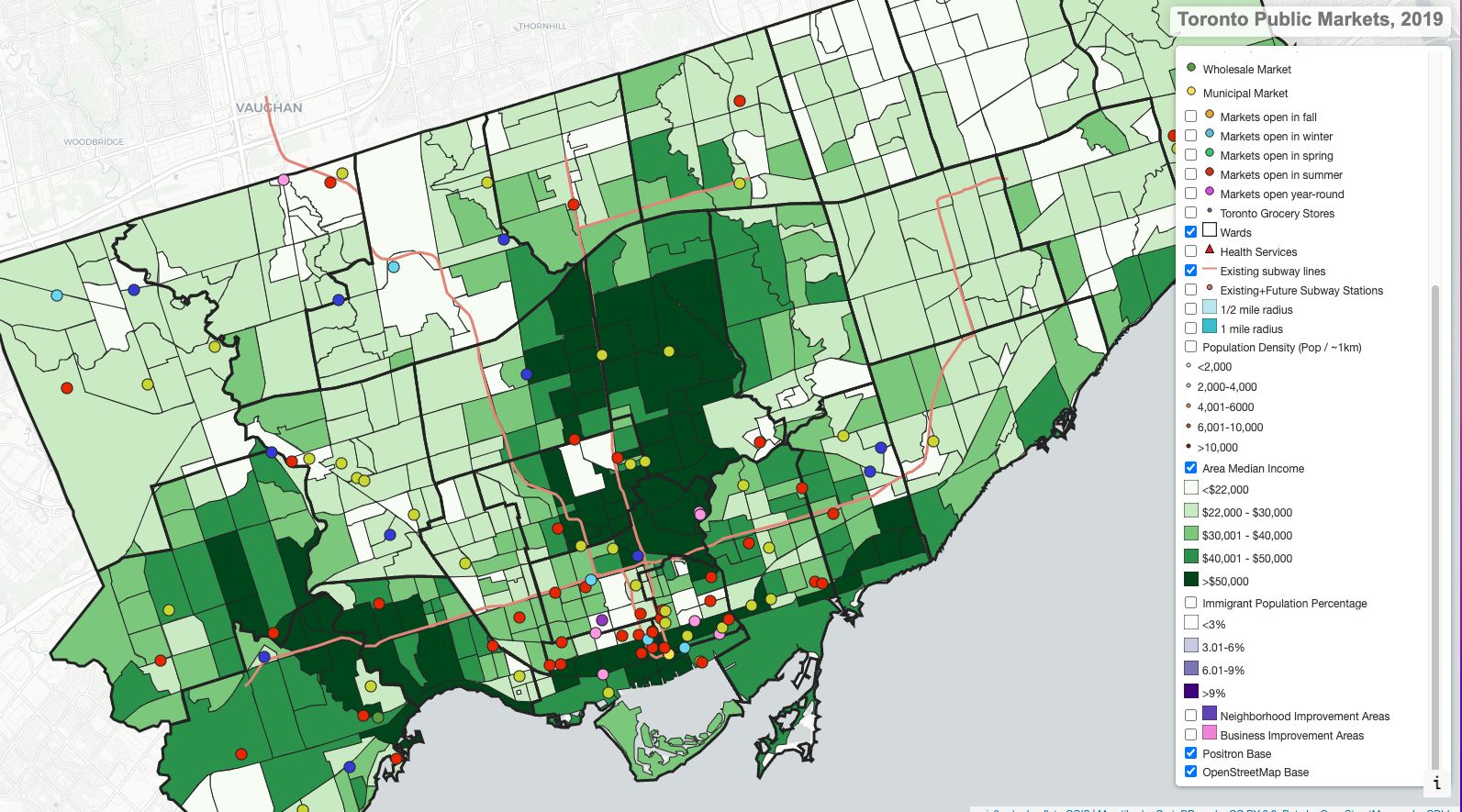
Toronto has more than 130 Public Markets (PM) built from the ground up by strong community champions or key anchor organizations.
They embrace diverse models, audiences and mandates that respond to residents’ needs and often deliver programs that address municipal gaps.
Though long-treasured by city-dwellers as a way to connect to local growers and urban entrepreneurs while surrounded by a festive atmosphere, markets provide entertainment and access to arts, crafts, street food and fresh produce. Still, the widespread benefits of public markets need to be discovered and appreciated. As such, many public markets exist on the margins.
From the St. Lawrence market, the only municipal market, to seasonal Farmers and Flea markets, to semi-permanent markets like Market 707 or the Ontario Food Terminal (Canada’s only wholesale market), these public markets are drivers of our local economy. These forms of retail are part of the mid-size distribution infrastructure that enables regional supply, inclusive and diverse economies and promote social connections at a neighbourhood level.
> Increase education on the role of the Public Market in city building.
> Celebrate Public Markets and the people & businesses involved.
> Promote the various forms of Public Markets our city.

Earth Month calls for a public Market Revolution! April, with Earth Day on the 22nd, highlights the urgency of climate action. Wildfires loom, threatening outdoor markets and the communities they sustain. Growers grapple with shifting conditions. How do we spark action? How do we rally support for grassroots initiatives battling climate change?
We know that Farmers’ Markets and new forms of community-based Markets led by younger folks are interested in reducing consumption and aligning their purchasing power with environmental and social values. These alternative forms of distribution are anchored in the community:
- Reducing the environmental impact of farming by supporting and promoting farmers using organic, ecological or bio-dynamic farming practices that reduce environmental impact on soil, water and habitats.
- Reducing food waste: farmers and food producers are “smart” about what they need to harvest to bring to market. Little food is wasted, and whatever is left after the market goes to another market or the compost bin at the farm. Customers purchasing food at markets also waste less because they buy what they need weekly.
- Preserving farmland in the right kind of farming by enabling farmers to have income through direct sales of sustainably grown food.
- Promoting seed diversity and heirloom varieties, leading to a more resilient ecosystem better prepared for climate change.
- Supporting and promoting smallholder livestock farming at a scale that supports good animal husbandry and is better aligned with the region's carrying capacity and reducing environmental footprint. (dairy and meat)
- Reducing food miles and CO2 emissions related to transportation and packaging required to move food and other goods over distances
- Reducing single-use plastics in the market by having practices, policies and programs that reduce the use of single-use plastic and overpackaging.
- Encouraging customers to reduce, re-use and repurpose clothes and household items, reducing the number of textiles and furniture ending up in landfills, especially at Flea, Vintage, and Antique Markets.
- Increasing education and providing concrete climate change actions for residents by creating places for face-to-face conversations with producers, increasing transparency and delivering programs that increase customers' understanding of the complexity of issues.
We recognize that significant issues go beyond what a single neighbourhood market can address. These include the under-representation of Indigenous people and their foodways, the difficulty of accessing land, income inequality, and the high cost of producing organic, artisanal food that is better for the environment but unaffordable for many residents, leaving people out. Additionally, marginalized communities are disproportionately affected by the impacts of climate change, which is an issue that needs to be addressed with urgency. However, market managers are committed to finding localized solutions (often filling institutional gaps) because they genuinely care about making a difference in their community.
PROBLEM
For nearly a century, governments worldwide have invested in a globalized food system, a legacy of colonial and imperial mindset, that aims to reduce the cost of production by moving people and goods across the globe. Through this process, the agro-food industry has externalized its adverse impacts on people and the planet. However, this is slowly catching up. A 2023 FAO global report, The State of Food and Agriculture, reveals that agrifood systems' global quantified hidden costs amount to 10 trillion dollars, of which over 20 percent represent environmental hidden costs, equivalent to almost one-third of agricultural value added. These costs are primarily associated with greenhouse gas (GHG) and nitrogen emissions and are relevant across all country income groups. An example of this is the USA's most significant Climate Solutions Investment Bill ever launched in 2023. While food loss and waste are the most significant sources of urban consumption-based emissions according to the United Nations, other industries like “fast fashion” every year, with 85% of unwanted textiles (worth US$100 billion) ending up in landfills. Equally important is “fast furniture,” with over 12 million tons of furniture ending up in United States landfills, negatively impacting workers, waters, non-human creatures, plants and the planet. And there is an urgent need to factor these costs into decision-making to transform the dominant model and level the playing field for alternative solutions.
What would happen if a portion of the “trillion dollar negative impact” was redirected to rebuilding local infrastructure (people and buildings) to strengthen the local supply of foods and other goods and increase its impact?
WHAT CAN WE DO
Only a few residents regularly visit and shop at their local markets, and often, the connection between regional supply and climate action is overlooked. We know that by capturing the stories of the work already happening in the community, we can provide a glimmer of hope to residents and customers and inspire more people to join the local movement to transform our food system and economy.
In our network, we have a few markets leading the work. Withrow Park Famers Market has an impressive annual report for their season. Evergreen Saturday Famers’ Market increased awareness and demonstrated the environmental benefits of shopping at their Famers’ Markets; the Junction Farmers’s Market successfully delivered a Waste Free campaign in 2018. Unfortunately, market managers and community-based organizations lack the resources to consistently implement, track, and report the year-to-year environmental initiatives.
Cities like Vancouver have already integrated local food assets (farmers markets, community food markets and urban agriculture) into their climate action. The Greenest Action Plan recognizes that a stronger food system reduces the environmental impact of food production and transportation, and they have set up a target to increase city-wide and neighbourhood food assets by a minimum of 50% over 2010 levels. We are also inspired by organizations like Farmers Market Coalition or ReLondon. Toronto still has a lot of work to do in this area. Public markets need to be adequately integrated into the City of Toronto's Climate Action plans, and there needs to be a process by which we can add up what individual markets are doing to demonstrate the sector's impact.
Let's ignite a public Market Revolution! And work together to amplify our impact through storytelling and data. At marketcityTO, we aim to find the resources and co-create a framework to collectively track and demonstrate our sector's environmental impact. If you want to be involved or support this project, please reach out to Marina Queirolo at mqueirolo@marketcityto.org
This blog sheds light on the vital role community markets play in advancing climate action. Happy Earth Month! See you at your neighbourhood market.

We have created the first Winter Market Map! Check these places to visit and shop locally from November to May.
As the cold and short winter months approach, it's essential to highlight the upcoming Winter and Holiday Markets. These markets play a crucial role in bringing vendors and customers together, especially for those experiencing social isolation during the cold and short winter days. However, we know that making these markets successful can be challenging. Often, customers don't show up, so sales are low, leaving managers and vendors exhausted, especially after the busy outdoor season and no winter rest.
Please help us spread the word and share information about these markets with your followers and networks. If your market or special holiday event is not included in our map, please complete this Google form so we can include it.
Let's work together to support our local communities during the winter season!

The International Market Cities Program began working with the Toronto Food Policy Council and Marina Queirolo, lead for the public market initiative, along with the two other pilot project cities: Pittsburgh, PA and Seattle, WA, in March 2020, at the beginning of the COVID-19 crisis.
In light of the pandemic, the Toronto partners' top priority was advocating for farmers' markets and fresh food markets to be declared essential services by the City.
During that time, thanks to the support of the University of Toronto Scarborough Feeding City Lab, we were able to collect baseline data on the public market system through meetings and interviews with key players in local food policy; surveying of markets; and mapping the public markets along with other data layers including wards, the subway system, population density, walking distance to markets, priority neighbourhood and business improvement areas, and grocery stores to identify gaps and opportunities for public markets. This 2019 data formed the basis for the first International report and public market interactive map,
Thanks, Glen Miller and Spacing Magazine, for writing about this important issue! We look forward to further collaboration and helping more planners, decision-makers and residents understand why we must support public markets.
Photo: Farmers Market at the Ontario Food Terminal, 400 farmers market tenants sell directly, and another 1,500 Ontario farmers sell indirectly through warehouse tenants. There are approximately 3,500 Ontario fruit and produce farmers in Ontario, 45% of which rely on the Ontario Food Terminal to sell all or part of their produce to independent green grocers and groceries.
http:/spacing.ca/toronto/2023/05/22/filling-in-the-missing-middle-for-food-retailing/
We work with Toronto’s intrepid market managers, vendors, city staff and policy-makers to activate the power of markets. Get in touch ->

Marina Queirolo
Public markets & food systems specialist
mqueirolo@marketcityto.org